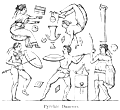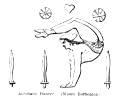Saltatio
(
ὄρχησις, χόρευσις). Dancing. The dancing of the Greeks
and Romans had little in common with the exercise which goes by that name in modern times. It
may be divided into two kinds, gymnastic and mimetic; that is, it was intended either to
represent bodily activity, or to express by gestures, movements, and attitudes certain ideas
or feelings, and also single events or a series of events, as in the modern ballet. All these
movements, however, were accompanied by music; but the terms
ὄρχησις and
saltatio were used in so much wider a sense than
our word dancing that they were applied to designate gestures even when the body did not move
at all (
saltare solis oculis,
Ov.
Met. x. p. 251).
We find dancing prevalent among the Greeks from the earliest times. It is frequently
mentioned in the Homeric poems: the suitors of Penelopé delight themselves with
music and dancing (
Odyss. i. 152); and Odysseus is entertained at the court of
Alcinoüs with the exhibitions of very skilful dancers, the rapid movements of whose
feet excite his admiration (
Odyss. viii. 265). Skilful dancers were at all
times highly prized by the Greeks: we read of some who were presented with golden crowns, and
had statues erected to their honour, and their memory celebrated by inscriptions.
The lively imagination and mimetic powers of the Greeks found abundant subjects for various
kinds of dances, and, accordingly, the names of no less than two hundred different dances have
come down to us. It would be inconsistent with the nature of this work to give a description
of all that are known: only the most important can be mentioned, and such as will give a
general idea of the dancing of the ancients.
Dancing was originally closely connected with religion. Plato thought all dancing should be
based on religion, as it was, he says, among the Egyptians. It has been shown under
Chorus that the chorus in the oldest times consisted of
the whole population of a city, who met in a public place to offer up thanksgivings to the god
of their country by singing hymns and performing dances. These dances, which, like all others,
were accompanied by music, were therefore of a strictly religious nature; and in all the
public festivals, which were so numerous among the Greeks, dancing formed a very prominent
part. We find, from the earliest times, that the worship of Apollo was connected with a
religious dance called
Hyporchema (q.v.). All the
religious dances, with the exception of the Bacchic and the Corybantian, were very simple, and
consisted of gentle movements of the body, with various turnings and windings around the
altar: such a dance was the
γέρανος, which Theseus is said to
have performed at Delos on his return from Crete. The Dionysiac or Bacchic and the Corybantian
were of a very different nature. In the former, the life and adventures of the god were
represented by mimetic dancing (see
Dionysia); the
dance called
Βακχική was a satyric dance, and chiefly
prevailed in Ionia and Pontus; the most illustrious men in the State danced in it,
representing Titans, Corybantians, satyrs, and husbandmen, and the spectators were so
delighted with the exhibition that they remained sitting the whole day to witness it,
forgetful of everything else. The Corybantian was of a very wild character: it was chiefly
danced in Phrygia and in Crete: the dancers were armed, struck their swords against their
shields, and displayed the most extravagant fury; it was accompanied chiefly by the flute. The
following wood-cut, from the Museo Pio-Clementino, is supposed to represent a Corybantian
dance. Respecting the dances in the theatre, see
Chorus.
 |
|
Corybantian Dancers. (Krause.)
|
Dancing was applied to gymnastic purposes and to training for war, especially in the Doric
States, and was believed to have contributed very much to the success of the Dorians in war,
as it enabled them to perform their evolutions simultaneously and in order.
There were various dances in early times which served as a preparation for war; hence Homer
calls the hoplitae
πρυλέες, a war-dance having been called
πρύλις by the Cretans. Of such dances the most celebrated
was the Pyrrhic (
ἡ Πυρρίχη), of which the
πρύλις was probably only another name.
The invention of this dance is placed in the mythical age, and is usually assigned to one
Pyrrhicos; but most of the accounts agree in assigning it a Cretan or Spartan origin, though
others refer it to Pyrrhus or Neoptolemus, the son of Achilles, apparently misled by the name,
for it was undoubtedly of Doric origin. It was danced to the sound of the flute, and its time
was very quick and light, as is shown by the name of the Pyrrhic foot
(˘˘), which must be connected with this dance: and from the same source
came also the Proceleusmatic (˘˘˘˘), or challenging
foot. The Pyrrhic dance was performed in different ways at various times and in various
countries, for it was by no means confined to the Doric States. Plato describes it as
representing, by rapid movements of the body, the way in which missiles and blows from weapons
were avoided, and also the mode in which the enemy was attacked. In the non-Doric States it
was probably not practised as a training for war, but only as a mimetic dance: thus we read of
its being danced by women to entertain a company. It was also performed at Athens at the
greater and lesser Panathenaea by Ephebi, who were called Pyrrhichists (
Πυρριχισταί), and were trained at the expense of the choragus.
The following illustration, taken from Sir W. Hamilton's vases, represents three
Pyrrhichists, two of whom, with sword and shield, are engaged in the dance, while the third is
standing with a sword. Above them is a female balancing herself on the
 |
|
Pyrrhic Dancers.
|
head of one, and apparently in the act of performing a somersault; she, no doubt, is
taking part in the dance, and performing a very artistic kind of
κυβίστησις, or tumbling, for the Greek performances of this kind surpass anything
we can imagine in modern times. A woman spectator, sitting, looks on at the exhibition.
The Pyrrhic dance was introduced into the public games at Rome by Iulius Cæsar,
when it was danced by the children of the leading men in Asia and Bithynia. It seems to have
been much liked by the Romans; it was exhibited both by Caligula and Nero, and also frequently
by Hadrian. Athenæus says that the Pyrrhic dance was still practised in his time
(the third century A.D.) at Sparta.
Other kinds of dances were frequently performed at entertainments, in Rome as well as in
Greece, by courtesans, many of which were of a very indecent and lascivious nature (Macrob.
Sat. ii. 10;
 |
|
Dancing-girl. (Pompeian painting.)
|
Plaut.
Stich. v. 2, 11), resembling the
tango of
the modern Spaniards, and the
danse du ventre of the Egyptian and Hindu
dancing-girls. The dancers seem to have frequently represented Bacchanals; many such dancers
appear in the paintings found at Herculaneum and Pompeii in a variety of graceful attitudes.
(
Museo Borbonico, vol. vii. tav. 34-40; vol. ix. tav. 17; vol. x. tav. 5, 6,
54.)
Among the dances performed without arms one of the most important was the
ὅρμος, which was danced at Sparta by youths and maidens together:
the youth danced first some movements suited to his age, and of a military nature; the maiden
followed in measured steps and with feminine gestures. Another common dance at Sparta was the
Bibasis (
βίβασις), which was much practised
both by men and women. The dance consisted in springing rapidly from the ground, and striking
the feet behind; a feat of which a Spartan woman in Aristophanes (
Lysistr. 28)
prides herself. The number of successful strokes was counted, and the most skilful received
prizes. We are told by a verse which has been preserved by Pollux (iv. 102), that a Laconian
girl had danced the
bibasis a thousand
 |
|
Acrobatic Dancer (Museo Borbonico.)
|
times, which was more than had ever been done before.
In many of the Greek States the art of dancing was carried to great perfection by females,
who were frequently engaged to add to the pleasures and enjoyment of men at their symposia.
These dancers always belonged to the courtesans. Xenophon (
Symp. ix. 2-7) describes a mimetic dance which was represented at a
symposium where Socrates was present. It was performed by a maiden and a youth, belonging to a
Syracusan, who is called the
ὀρχηστοδιδάσκαλος, and
represented the loves of Dionysus and Ariadné.
Dancing was common among the Romans in ancient times in connection with religious festivals
and rites, and was practised, according to Servius (
ad
Verg. Ecl. v. 73), because the ancients
thought that no part of the body should be free from the influence of religion. The dances of
the Salii, which were performed by men of patrician families, are spoken of elsewhere. (See
Salii.) There was another old Roman dance of a
military nature, called
bellicrepa saltatio, which is said to have been
instituted by Romulus, after he had carried off the Sabine women, in order that a like
misfortune might not befall his State (Festus,
s. v.). Dancing,
however, was not performed by any Roman citizen except in connection with religion; and it is
only in reference to such dancing that we are to understand the statements that the ancient
Romans did not consider dancing disgraceful, and that not only freemen but the sons of
senators and noble matrons practised it (Quintil.
Inst. Orat. i. 11, 18). In
the later times of the Republic we know that it was considered highly disgraceful for a
freeman to dance: Cicero reproaches Cato for calling Murena a dancer (
saltator), and adds, “Nemo fere saltat sobrius, nisi forte insanit”
(
Pro Muren. 6, 13;
In Pison. 10, 22). The professional
dancing-girls at Rome came from foreign countries, oftenest from Spain; and those of Gades
(Cadiz) were especially noted for the indecent suggestiveness of their performances.
The mimetic dances of the Romans, which were carried to such perfection under the Empire,
are described under
Pantomimus. Respecting the
dancers on the tight-rope, see
Funambulus.
See Meursius,
Orchestra; Burette,
De la Danse des Anciens;
Krause,
Gymnastik und Agon. d. Hell. p. 807; Schömann,
Antiq. p. 58; Becker-Göll,
Charikles, i. 166;
Blümner,
Privatleben, p. 505; Marquardt,
Privatleben,
p. 109;
Czerwinski, Geschichte der Tanz-Kunst (1862); and
Voss, Der Tanz und seine Geschichte (1868).








